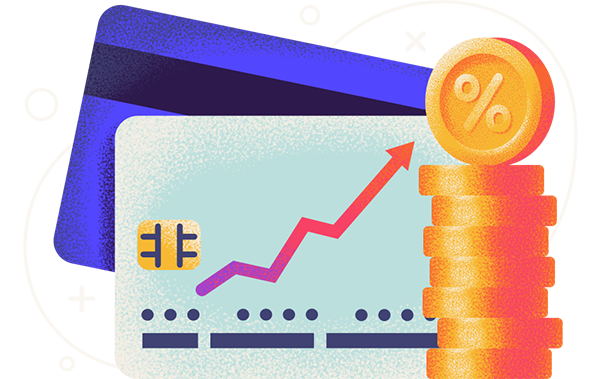What Is an Interest Rate?
An interest rate is a percentage that shows the pace at which an amount of money will grow over time. For example, if someone gives you a one-year loan of $100 with a 10% interest rate, you’d owe them $110 back after 12 months. Interest rates obviously work against you as a borrower, but they benefit you as a lender, such as when you put money in a bank account.
Key Things to Know About Interest Rates
- Purpose: An interest rate allows a lender to calculate how much to charge the borrower for the privilege of borrowing money. When you deposit money in a bank account, the interest rate determines how much money you earn in return.
- Where to find it: When you open a loan or line of credit, the interest rate is listed on your borrowing agreement and in your online account. The interest rate you get for putting money in a bank account is also listed on the agreement you sign to open the account.
- Fixed vs. variable: Your interest rate may be fixed, meaning it always stays the same, or variable, meaning it can go up or down based on changes in the economy.
How Do Interest Rates Work?
Interest rates work for you when you deposit money in a bank account, and they work against you when you borrow money. In both cases, the interest rate stated in the account’s terms and conditions will be applied to your balance (either from the start or when certain conditions are met) at regular intervals. The resulting interest charges are then added to the balance, compensating the lender or depositor for the time value of their money.
For certain types of interest, the math can get a bit complicated, but the main factors involved are always the percentage of interest charged, the amount of money borrowed or deposited, and the length of time involved.
Below, you’ll find additional information on how interest rates work, from how they’re determined and calculated to the different types of rates you might encounter.
Interest calculation: An issuer may calculate interest on a yearly, monthly or even daily basis. However, certain vehicles for borrowing money, like credit cards, may not apply the interest rate if you pay your balance in full each month.
Multiple types: Some lenders may specify multiple types of interest rates. For example, credit cards may have a separate interest rate for balance transfers, cash advances or late payments.
How they’re determined: Interest rates are heavily determined by factors like your credit score and your income. The higher your credit score and income are, the lower your interest rate is likely to be.
Interest rate ranges: Lenders typically disclose both a minimum and a maximum interest rate available on their financial products.
Interest Rate vs. APR
You may have heard the terms “interest rate” and “APR” used interchangeably. While they are similar, there are a few key distinctions between the two. APR, or annual percentage rate, is the yearly cost of borrowing. It generally includes interest as well as fees and other charges tacked on to the principal amount you owe.
Some, but not all, loans charge fees. On a mortgage, for example, you might have to pay processing fees, closing costs, and mortgage insurance premiums, among other things. Your lender may include some of these fees in the APR. In other words, the lender calculates what the payment rate for these fees would be if they were spread evenly across the entire lending period. Then, that number gets combined with the interest rate to form the APR. So naturally, if a loan’s APR and interest rate are different, the APR is always higher.
Credit cards are the exception. Their APRs don’t include fees and are just used to calculate daily interest. In addition, some personal loan providers that charge origination fees will include this fee in the APR, while others will not.
Types of Interest Rates
You might come across several different varieties of interest rates, especially on a credit card. Here are some of the most common types of interest rates:
- Regular rate: The interest rate you pay under normal circumstances, when you don’t have a lower promotional rate and you’re making your payments on time.
- Purchase intro rate: This is a temporarily lower rate, often 0%, that you may get for a certain number of months after opening a credit card account.
- Balance transfer rate: When you use a credit card to pay off another credit card or loan, the resulting balance accrues interest at this rate. A so-called balance transfer only makes sense if the card doing the paying has a lower interest rate than the account being paid off. That’s why balance transfer rates are often temporarily lower than normal, sometimes 0%, for a period of time after a balance transfer credit card is opened.
- Penalty rate: This is a higher rate that kicks in if you don’t pay on time. On a credit card, only purchases made after the penalty rate takes effect are subject to higher interest charges at first. But this rate can apply to your entire balance if you become 60 days delinquent on making a minimum payment. You can regain your regular interest rate after paying on time for 6 months. The law requires all issuers to comply with this rule.
- Cash advance rate: If you withdraw money from an ATM with your credit card, you’ll have to pay a fee and the balance will immediately have a pretty high cash advance interest rate. The average cash advance APR is 24.79%, according to WalletHub’s data, and cash advances don’t get a grace period like regular credit card purchases do.
- Annual percentage yield (APY): The amount of money you earn on a deposit in one year’s time. It factors in compound interest.
- Prime rate: The interest rate banks charge other banks and large corporations.
- Real interest rate: An interest rate that’s been adjusted for inflation.
Fixed vs. Variable Interest Rates
The difference between fixed and variable rates is that fixed interest rates don’t change, while variable rates can go up and down over time. Variable interest rates are typically indicated by a (V) after the percentage.
Fixed Interest Rates: A fixed interest rate never changes over the life of the financial product. It won’t go up or down due to any external factors in the market. This is especially common on personal loans, auto loans, and mortgages. It’s rare for a credit card to have a fixed interest rate.
Variable Interest Rates: A variable interest rate can change over time. Usually, the changes are tied to an index, like the “prime rate” at which banks lend to their most creditworthy customers. As the prime rate or other index goes up and down, the interest rates on financial products will also fluctuate. Variable interest rates are found on the vast majority of credit cards, as well as some mortgages.
For some types of financial products, you won’t have a choice of a fixed or variable interest rate. For others, you will. In that case, fixed interest rates tend to be better for people who like stability and don’t want to risk their rates increasing. Variable interest rates may be more appealing for consumers who are more willing to take risks and believe conditions will improve in the near future.
Simple vs. Compound Interest
Calculating the interest charges that you can expect based on your interest rate can be very easy or very complex. It all depends on the terms of the loan or line of credit. To start off, the amount of money you borrow is called the “principal.” You’ll need to pay at least this entire amount back. If you have an interest-free loan, or if you borrow money on a credit card and pay it off by the due date (or within a 0% intro APR period), you won’t owe any more.
If you carry a balance on your credit card or your loan does charge interest, the amount you pay will depend on the length of time you owe the money. It also depends on which of the two major forms of interest applies: simple interest or compound interest.
Simple Interest
Simple interest is the amount you borrowed, multiplied by the interest rate, multiplied by the number of periods during which the issuer charges interest (e.g. 5 if you’re charged by the year and have the loan for 5 years). Periods could be years, months, days, etc.
Simple Interest Example:
- Amount Borrowed: $1,000
- APR: 15%
- Loan Term: 5 years
- Interest Calculation: $1,000 * 0.15 * 5 = $750
- Total Amount Paid: $1,000 principal + $750 interest = $1,750
Sadly, most loans don’t make calculations this easy. Most types of interest, including credit card interest, compound over time.
Compound Interest
Compound interest is when interest accrues interest. More specifically, it’s when the interest rate applies to both the principal amount owed and interest assessed previously. How often that happens is the rate at which interest compounds. An interest rate might compound yearly, monthly, daily, etc. Credit card interest compounds daily.
You can use WalletHub’s free credit card interest calculator to see how much interest you’d owe when paying off a debt with a certain monthly payment or over a certain period of time.
How Are Interest Rates Determined?
There are a number of different factors that can affect your interest rate. You can have a direct impact on some of these factors, but not all of them. They include:
- Your credit score: The higher your credit score is, the more trustworthy you are as a borrower and the less risk there is for the lender. Less risk generally leads to lower interest rates.
- Your income: The higher your income is, the more likely you are to pay back what you owe, and the lower your rates are likely to be.
- The creditor’s range: You’ll get an interest rate somewhere between the lender’s minimum and maximum. Sometimes there will only be one rate for all borrowers, though.
- The economy: If your interest rate is variable, it may go up and down due to fluctuations in the economy. Interest rates are often tied to an index rate, like the “prime rate” at which banks lend to their most creditworthy customers.
- The expiration of an intro rate: When an introductory interest rate expires, it causes a sudden jump in the interest rate on your remaining balance.
- Missed payments: Missed payments can trigger a penalty APR, which applies to new purchases first and to your whole balance if you’re more than 60 days delinquent.
It’s important to remember that some of the factors that affect interest rates are out of your control. But if your personal credit is excellent, you’re more likely to get a lower interest rate. That means good behavior gives you some leverage.
Also, when you get a credit card, make sure you know what the APR is, and try to always pay off your balance by the due date in order to avoid interest entirely. Daily-compounded interest can really add up. You can learn more about credit card interest here on WalletHub.



WalletHub experts are widely quoted. Contact our media team to schedule an interview.